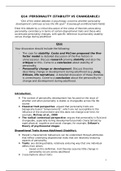Q14: PERSONALITY (STABILITY VS CHANGEABLE):
“One of the oldest debates in psychology concerns whether personality
development continues across the life span” (Cavanaugh and Blanchard-Fields)
Enter this debate by a critical discussion of the views of theorists advocating
personality consistency in terms of certain dispositional traits and those who
accentuate personality changes, with specific reference to personality stability
versus change during adulthood
Q14:
Your discussion should include the following:
- The case for stability: Costa and McCrae proposed the five-
factor model (a detailed discussion of the five factors in
unnecessary). Discuss research proving stability and also the
critique on this. Come to a conclusion about stability of
personality.
- Personality change or development: Discuss theories
describing change or development during adulthood (e.g. Jung,
Erikson, life narratives). A detailed discussion of these theories
is unnecessary. Come to a conclusion about the personality for
change and development during adulthood.
Introduction:
The context of personality development has focused on the issue of
whether and when personality is stable vs changeable across the life
course
Classical trait perspective: argued that personality traits are
biologically based “temperaments”, which are not susceptible to the
influence of the environment and this does not change over time, for
example, McCrae et al., 2000
The radical contextual perspective: argues that personality is fluid and
changeable, especially during developmental periods characterized by
rapid physical, cognitive and social changes, for example, Erikson’s
theory of psychosocial stages
Dispositional Traits Across Adulthood (Stability):
People’s characteristic behaviours can be understood through attributes
that reflect underlying dispositional traits that are relatively enduring
aspects of personality
Traits: any distinguishable, relatively enduring way that one individual
differs from others
o based on this definition, trait theories assume little change in
personality occurs across adulthood
3 assumptions about traits:
1
, o 1.) traits based on comparisons of individuals because there are no
absolute quantitative standards for concepts such as friendliness
etc.
o 2.) qualities of behaviours making up for a particular trait must be
distinctive enough to avoid confusion
o 3.) the traits attributed to a specific person are assumed to be
stable characteristics
These 3 assumptions are all captured within the definition of a trait
The structure of traits concerns the way traits are organized within the
individual. This organization usually inferred from the pattern of
related/unrelated personality characteristics and are generally expressed
in terms of dimensions. Personality structures are examined over time to
see whether they change with age.
Thus, trait theories – little change in personality occurs across adulthood
The Case for Stability in Personality: The Five-Factor Model:
Proposed by Costa and McCrae
Their model is strongly grounded in cross-sectional longitudinal and
sequential research
The five-factor model consists of 5 independent dimensions of personality:
neuroticism, extraversion, openness to experience, agreeableness and
conscientiousness
o Neuroticism:
- *6 facets of neuroticism: anxiety, hostility, self-
consciousness, depression, impulsiveness and vulnerability
- Anxiety and Hostility form underlying traits for two
fundamental emotions – fear and anger
- Traits of self-consciousness and depression relate to
emotions of shame and sorrow
- Impulsiveness: give into temptation -> lack of willpower and
self-control
- Vulnerability: lowered capability to deal effectively with stress
- *High neuroticism: violent and negative emotions that
interfere with people’s ability to handle problems or get along
with people
o Extraversion:
- *6 facets grouped into 3 interpersonal traits (warmth,
gregariousness and assertiveness) and 3 temperamental
traits (activity, excitement seeking and positive emotions)
- Warmth and gregariousness: a desire to be with other people
– sociability. Thrive in crowds
- Assertive people: natural leaders
- Temperamentally: extroverts like to keep busy; endless
energy
- Extroverted people tend to have people-oriented jobs
o Openness to Experience:
- 6 facets represent 6 different areas:
Fantasy: vivid imagination and active dream life
Aesthetics: appreciation of art/beauty, sensitivity to
pure experience for own sake
2





